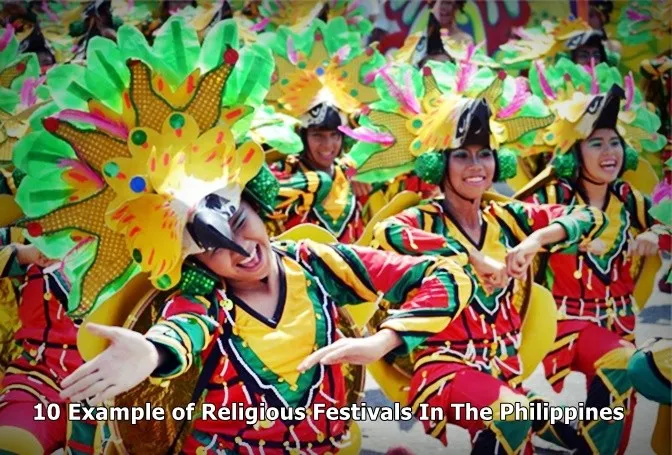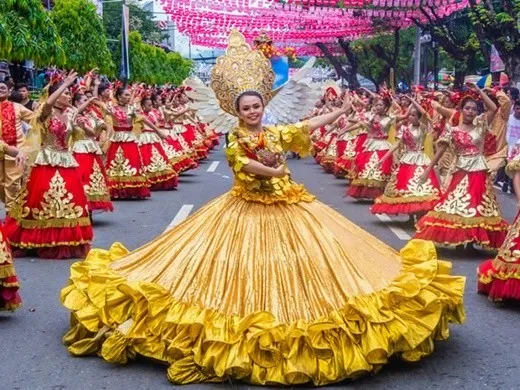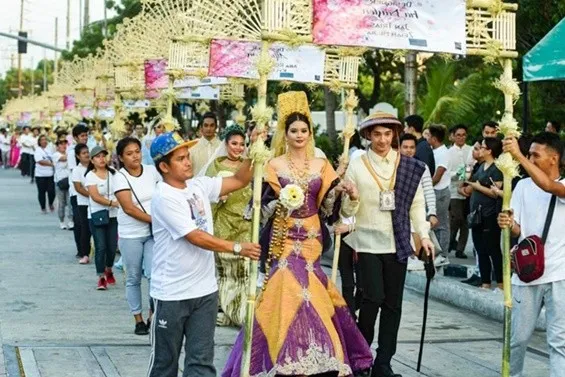The Philippines is a country rich in culture and diversity, with a unique blend of religions and traditions that have been embraced and celebrated by its people for centuries. From indigenous beliefs to Christianity to Islam, there are numerous religious festivals throughout the year that Filipinos can join in on.
These festivals are not only expressions of faith and devotion but also showcases of the colorful and vibrant heritage of the nation. They feature spectacular parades, dances, rituals, and ceremonies that honor various deities, saints, ancestors, or natural phenomena. They also offer opportunities for fun, socialization, and enjoyment with family, friends, and strangers.
In this article, we will explore ten of the best religious festivals from across the country that will be a highlight of any visit to the Philippines. From solemn processions to lively street parties, every festival is an unforgettable experience that celebrates faith, culture, and tradition. Also Read Religious Festivals in the Philippines

10 Example of Religious Festivals In The Philippines
1. Sinulog Festival – Cebu

Sinulog Festival is one of the most popular and oldest festivals in the Philippines. It takes place every year on the third Sunday of January in Cebu City to honor their patron saint, Señor Santo Niño de Cebu. The festival is celebrated with a lot of enthusiasm by locals and tourists alike who come together to pay homage to their patron saint.
The event is a grand parade of costumes, music, and dance that follows the rhythm of drums played by locals in honor of Señor Santo Niño de Cebu. Participants dress up as colorful characters while they join the festivities. Along with the parade, there are different religious activities like Mass, processions, and concerts taking place throughout the festival. There are also food stalls selling local delicacies like lechon and siopao.
The entire event is an amazing display of faith and culture coming together in celebration of Sinulog. The festival is also known as the “mother of all festivals” and the “grandest festival” in the Philippines because of its scale and significance.
2. Ati-Atihan Festival – Aklan

Ati-Atihan Festival is an annual festival celebrated in Kalibo, Aklan on the third week of January. It marks a celebration of faith honoring the Santo Niño (Holy Child), as well as Atis, the local indigenous people who were believed to be the first inhabitants of Panay Island.
The festival includes vibrant parades of locals wearing colorful costumes and masks and dancing to the rhythm of drums. Ati-Atihan is also known for its lively street parties, with several stages featuring live music and performances all throughout the day. There are other activities like Mass, processions, cultural shows, and beauty pageants that take place during the festival as well.
Food stalls selling local delicacies, as well as vendors selling souvenirs and religious items are also available during the event. With a unique blend of culture and religious tradition, Ati-Atihan is an unforgettable experience that celebrates faith and community spirit.
3. Black Nazarene Procession – Manila

Black Nazarene Procession is an annual event that takes place every January 9 in Quiapo, Manila. It is one of the most solemn and sacred festivals in the Philippines that attracts millions of devotees who seek healing, miracles, or blessings from the image of the Black Nazarene, a life-sized statue of Jesus Christ carrying a cross.
The procession is a massive and intense event that involves carrying the image from Quirino Grandstand to Quiapo Church, a distance of about 6 kilometers. Devotees wear maroon shirts and walk barefoot as they try to touch or kiss the image, or wipe it with their towels or handkerchiefs. They also chant “Viva Señor” or “Hail Lord” as they follow the image.
The procession is a display of extreme faith and devotion that can last for several hours or even days. The image of the Black Nazarene is believed to have miraculous powers that can heal diseases, grant wishes, or protect from harm. The festival is also a way of commemorating the passion and suffering of Jesus Christ.
4. Flores de Mayo – Nationwide

Flores de Mayo (Flowers of May) is a month-long festival celebrated throughout the Philippines during the month of May. It is a tribute to the Virgin Mary, the mother of Jesus Christ, and a celebration of the flowers that bloom during this season.
The festival involves various activities like floral offerings, processions, novenas, and masses dedicated to Mary. One of the highlights of the festival is the Santacruzan, a parade of young women dressed as biblical characters or historical figures who represent different virtues or attributes of Mary. The parade is usually led by a girl carrying a cross who represents Reyna Elena (Queen Helena), the mother of Constantine the Great who found the true cross of Jesus Christ.
The festival is a showcase of beauty and grace that honors Mary as the Queen of Heaven and Earth. It is also a way of expressing gratitude for her intercession and protection.
5. Our Lady of Peñafrancia – Naga
Our Lady of Peñafrancia is an annual festival celebrated in Naga City, Camarines Sur on the third Saturday of September. It is one of the most important and largest Marian festivals in the Philippines that honors the miraculous image of Our Lady of Peñafrancia, the patroness of Bicol.
The festival involves various activities like novenas, masses, processions, cultural shows, and fireworks. The highlight of the festival is the fluvial procession, where the image of Our Lady of Peñafrancia is transferred from her shrine to the Naga Cathedral via the Naga River. Thousands of devotees join the procession on foot or on boats, waving white handkerchiefs and chanting “Viva la Virgen” or “Long live the Virgin”.
The festival is a display of faith and devotion that attracts millions of pilgrims from all over the country and abroad. The image of Our Lady of Peñafrancia is believed to have performed countless miracles for those who seek her help and guidance.
6. Eid al-Fitr – Nationwide

Eid al-Fitr is an Islamic festival that marks the end of Ramadan, the holy month of fasting and prayer for Muslims. It is a joyous occasion that celebrates the completion of the spiritual journey and the gratitude for Allah’s blessings. It is also a time of charity, forgiveness, and unity among Muslims.
Eid al-Fitr is celebrated with prayers, feasts, gifts, and greetings. Muslims wear new or clean clothes and visit mosques to perform the Eid prayer. They also give alms to the poor and needy, called Zakat al-Fitr, as a way of sharing their blessings. They also visit their relatives and friends, exchange greetings of “Eid Mubarak” or “Blessed Eid”, and give gifts or money to children.
Eid al-Fitr is a festival that reflects the diversity and harmony of the Muslim community in the Philippines. It is also a way of showing respect and appreciation for the Islamic faith and culture.
7. Santo Niño Festival – Nationwide
Santo Niño Festival is a nationwide festival that honors the Holy Child Jesus, one of the most revered icons in Philippine Catholicism. The festival is celebrated on different dates and locations across the country, but the most common date is the third Sunday of January.
The festival involves various activities like Masses, processions, parades, dances, and rituals that pay tribute to the Santo Niño. The image of the Santo Niño is usually dressed in elaborate costumes and adorned with jewels and accessories. Devotees carry or display the image in their homes, cars, or businesses as a way of expressing their faith and devotion.
The festival is a manifestation of the Filipino’s childlike and joyful spirit that celebrates life and blessings. It is also a way of honoring the Filipino’s history and identity that was influenced by Spanish colonization.
8. Obando Fertility Dance – Bulacan
Obando Fertility Dance is an annual festival celebrated in Obando, Bulacan on May 17 to 19. It is a unique and ancient festival that seeks the intercession of three patron saints: San Pascual Baylon (Saint Paschal), Santa Clara de Asis (Saint Clare), and Nuestra Señora de Salambao (Our Lady of Salambao).
The festival involves a dance ritual that is performed by couples or individuals who wish to have children, find a spouse, or solve marital problems. They dance to the beat of drums and sing songs of praise to the saints. They also wear colorful costumes and carry images or statues of the saints.
The festival is a display of faith and hope that believes in the power of prayer and miracles. It is also a way of preserving the Filipino’s cultural heritage and traditions.
9. Pahiyas Festival – Quezon
Pahiyas Festival is an annual festival celebrated in Lucban, Quezon on May 15. It is a harvest festival that honors San Isidro Labrador (Saint Isidore), the patron saint of farmers. The festival is also a thanksgiving for nature’s bounty and a showcase of Lucban’s agricultural products.
The festival involves decorating houses with colorful kiping (rice wafers) and other agricultural products like fruits, vegetables, flowers, and handicrafts. The decorations form elaborate patterns and designs that reflect the creativity and ingenuity of the locals. The festival is also a way of showcasing the town’s local products and crafts.
The festival is a display of creativity and artistry that celebrates the harvest and the patron saint. It is also a way of promoting tourism and local culture.
10. Pintados-Kasadyaan Festival – Leyte
Pintados-Kasadyaan Festival is an annual festival celebrated in Tacloban City, Leyte on June 29. It is a fusion of two festivals: Pintados, which honors the ancient warriors of Leyte who tattooed their bodies as a sign of bravery and strength; and Kasadyaan, which means merriment or joy.
The festival involves various activities like Masses, processions, cultural shows, sports events, and concerts. The highlight of the festival is the Pintados-Kasadyaan Festival of Festivals, where different towns and cities in Leyte showcase their own festivals through colorful costumes, music, and dance. The participants paint their bodies with intricate patterns and designs that resemble the tattoos of the ancient warriors.
The festival is a display of history and heritage that celebrates the spirit and culture of Leyte. It is also a way of fostering unity and cooperation among the different communities in the province.
FAQs
What are religious festivals?
Religious festivals are celebrations that are based on or influenced by religious beliefs, traditions, or events. They usually involve rituals, ceremonies, prayers, or worship that express devotion or gratitude to a deity, saint, or phenomenon. They also often include cultural or social elements that reflect the values and identity of the people who celebrate them.
Why are religious festivals important?
Religious festivals are important because they:
- Provide a sense of belonging and community among people who share the same faith or culture
- Strengthen the faith and devotion of the participants and inspire them to live according to their religious teachings
- Honor and commemorate the sacred or significant events or figures in their religion or history
- Express gratitude and appreciation for the blessings and gifts they receive from their deity or nature
- Showcase and preserve the rich and diverse culture and heritage of their religion or region
- Promote tourism and economic development by attracting visitors and showcasing local products and services
How do Filipinos celebrate religious festivals?
Filipinos celebrate religious festivals in various ways depending on their religion, region, or preference. Some common ways are:
- Attending Masses, processions, novenas, or other religious services that are dedicated to their patron saint or deity.
- Participating in parades, dances, rituals, or ceremonies that honor their patron saint or deity or depict their religious stories or events.
- Decorating their houses, streets, churches, or shrines with flowers, lights, banners, statues, or other symbols that represent their patron saint or deity.
- Preparing and sharing food, drinks, gifts, or money with their family, friends, neighbors, or strangers as a way of celebrating and showing generosity.
- Joining street parties, concerts, fireworks displays, or other entertainment activities that create a festive and joyful atmosphere.
Related Posts